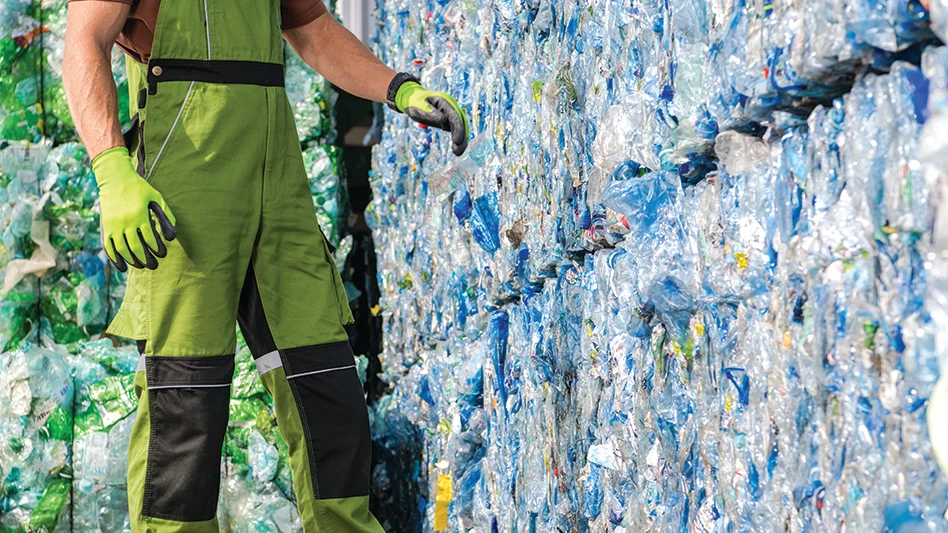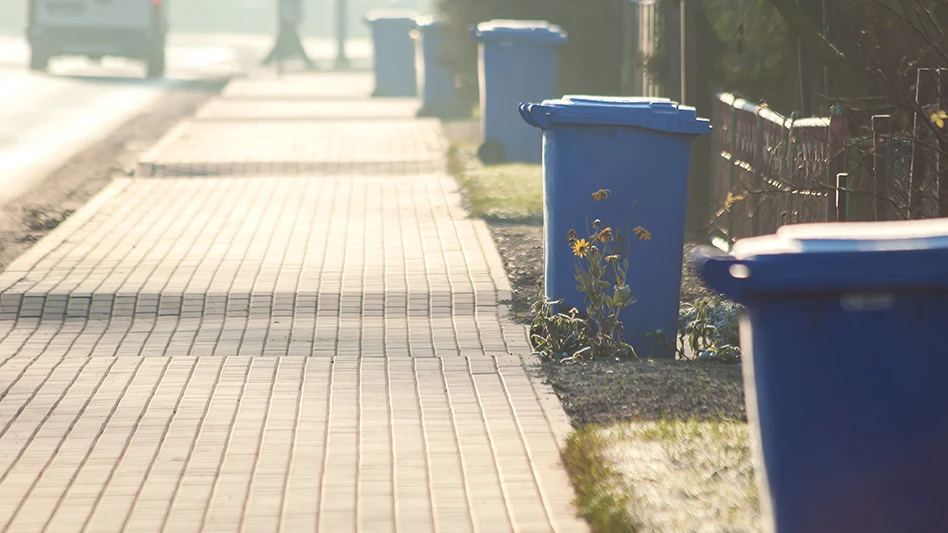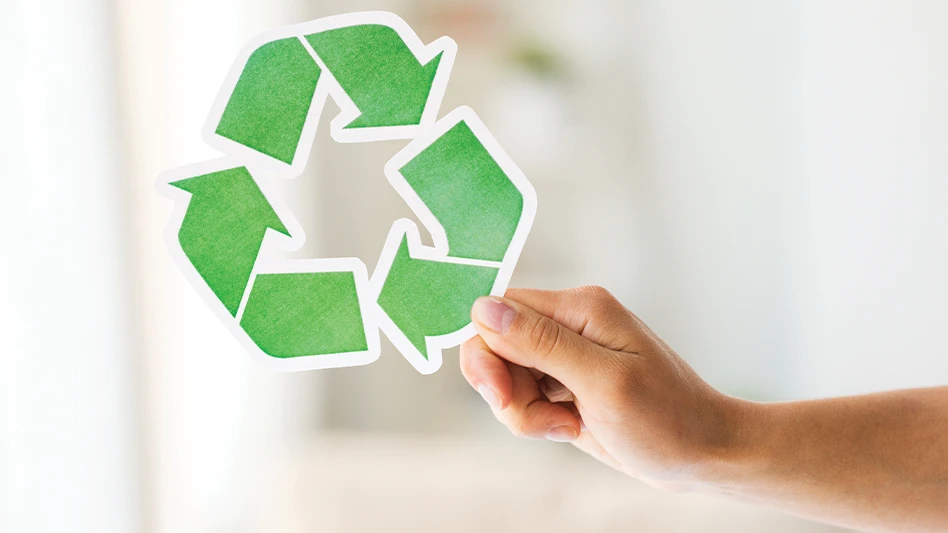

Recology’s Recycle Central is not among San Francisco’s Golden Gate Park and Fisherman’s Wharf as one of the city’s must-see attractions, but perhaps the material recovery facility (MRF) the company operates on the bulk cargo marine terminal Pier 96 should be.
Designed and constructed by Recology in partnership with the city of San Francisco, Recycle Central opened in 2002 and is a key component in achieving the city’s zero waste goal. Collection trucks operated by Recology deliver between 650 and 700 tons of recyclables from homes, apartment buildings and commercial properties in San Francisco to Recycle Central per day. The material is sorted into 14 different commodities, baled and shipped to domestic and international markets.
Over the past four years, Recology has invested $20 million in major retrofits at the MRF to continue producing the clean, high-quality commodities the business is known for. The upgrades included updating the screening and sorting system in 2016, installing three additional optical sorters in 2018 and adding four robotic sorters in 2019. General Manager Maurice Quillen, who has been with Recology for more than 30 years, has overseen the retrofits and kept operations running during each modernization.
“There’s one key driver behind all the upgrades at the facility, and that’s the change in the composition of the material we have to sort today versus the composition of the material we had to sort 20 years ago when we built the facility,” he says.
Sorting technology is key
The incoming fiber stream, which makes up about 75 percent to 85 percent of the recyclables at Recycle Central, has shifted over the years. Cardboard is abundant in the curbside stream, whereas newspaper was prominent when the facility was built, Quillen says.
“We’ve really had to increase the size of the fiber screens in order to sort the material and add a cardboard screen to separate the cardboard from other recyclables,” he says. “There was so much cardboard coming into the system, it was choking the fiber screen.”

In 2016, Recycle Central installed two optical sorters supplied by Van Dyk Recycling Solutions, Norwalk, Connecticut, to achieve better throughput and material recognition. This doubled the number of optical sorters the MRF used. The optical units sort containers as well as “pull out any paper or containers that we missed” from the initial sort, Quillen says.
The plastics stream also has shifted to include hard-to-recycle bulky plastics, films and flexible plastic packaging. Recycle Central takes extra steps to keep plastic bags and plastic film out of finished bales of recycled paper, he says. In 2018, it became the first MRF in North America to work with Pertuis, France-based Pellenc ST to install three optical units for fiber recovery.
Incoming material goes through a series of screens that separate the paper from plastic containers before the paper stream reaches the Pellenc optical sorters for quality control, Quillen explains.
“We’re very happy with that installation,” he says. “I like the Pellenc units a lot. We are sub-1 percent contamination on our fiber bales at this point, and we are negatively sorting fiber. I don’t think there’s too many MRFs that are negatively sorting fiber at sub-1 percent contamination, and the Pellenc optical sorters are key to that whole process.”
Working with robots
Last year, Recycle Central worked with Bulk Handling Systems (BHS), Eugene, Oregon, to install four Max-AI AQC (Autonomous Quality Control) units and one VIS (Visual Identification System) at Recycle Central, which are important to achieving the less than 1 percent contamination that many domestic mills and manufacturers require.
John Ferrari, the senior operations manager at Recycle Central, says the MRF’s robotic sorters are learning to identify different types of plastics, remove them from the conveyor belts of mixed materials at “rapid speeds” and deposit them into the appropriate areas for further sorting.
One robot is dedicated to removing thermoformed packaging—clamshells, cups, tubs, lids and trays—from the container line, Quillen says. “It’s all PET (polyethylene terephthalate), but it’s different quality and generally affects how we market the material and our pricing, so we dedicated one robot to simply pull out thermoform PET from the optically sorted PET stream,” he explains.
Quillen says the robotic sorters are “high-maintenance” equipment and there’s a “learning curve” to operating them.
Jamming and clogging on the robotic line because of plastic film is an issue Recology proactively works to avoid. Ferrari says Recycle Central works to “eliminate as much plastic film as possible before material hits the robotic lines.” The suction head of the robots are watched “closely” to maintain optimal performance.
“There’s one key driver behind all the upgrades at the facility, and that’s the change in the composition of the material.” – Maurice Quillen, general manager, Recology’s Recycle Central
The material on the conveyor belt also needs to be spread out evenly for better performance, he adds.
“We understood that we would have to deal with the learning curve of the robots, so they understand what it is they have to sort,” Quillen says. “You need to be proactive in that. You’ve got to pay attention to what the robots are missing and make sure you’re working with your equipment vendor to let them know these are the items we need to introduce into the recognition system, so it can sort them.
“We had to bring on additional mechanics to support the robots throughout the day,” Quillen continues. “We have someone assigned to the container line that walks the line during the shift to make sure the robots are doing what we’re asking them to do.”
Extra quality control
Recology has a reputation for producing high-quality bales of recyclables, which Quillen attributes to the company’s “holistic approach to quality.”
For example, Recology operates a curbside composting program and completed a $19 million expansion of its transfer station in December 2019. The transfer station’s new 16,000-square-foot West Wing processes about 800 tons of food scraps and yard trimmings per day. The composting program helps keep food and liquids out of Recycle Central, which gives the sorters and robots a better chance at producing quality finished bales, says Robert Reed, public relations manager at Recology.

Recycle Central also claims to have the longest initial sort line in North America. Of the 200 employees who work at the facility, 170 are involved in sorting as well as maintenance, Quillen says.
He adds that working with recycling industry veterans, including Recycle Central’s maintenance manager who has been in the recycling industry for 40 years, is a big part of Recycle Central’s success. “They understand the plant and the issues we’re going to deal with,” he says.
Despite veteran personnel, the MRF is not without its challenges. “Every day, we’re sending around 10 percent of all [incoming] tons to the landfill because there’s items that aren’t recyclable,” Quillen says. “We have the same issues with organics. People put things in the organics bins that are not compostable.”
Supply chain engagement
Materials processed at Recycle Central are baled and shipped to domestic and international markets. Steel and aluminum are sent to foundries in the United States, while paper and cardboard bales go to paper mills in the U.S., Canada and countries that border the Pacific Ocean. Glass goes to a glass manufacturing plant in northern California, where it’s recycled into new bottles within six weeks, Quillen says.
In the last 18 months, many global brands and consumer goods companies have made a pilgrimage to Recycle Central to see how their products fare in the recycling plant, Reed says. For example, a company that makes candy sent 20 pounds of wrappers to the facility to test their recyclability. Recycle Central ran the material through its system and created a storyboard to show company executives how much of the packaging would be recycled, composted or sent to landfill.
“They dialogue with us on what can be recycled and what can’t,” Reed says, adding that Recology offers suggestions on how brands can improve their packaging to make it more recyclable or even to use less of it.
While the growing packaging stream presents challenges for Recycle Central and the wider recycling industry, it also offers new opportunities. For example, the facility now recovers curbside-collected aseptic containers.

Explore the March 2020 Issue
Check out more from this issue and find your next story to read.
Latest from Recycling Today
- EPA releases ‘National Strategy to Prevent Plastic Pollution’
- South Carolina launches recycling app
- Resource Recycling Systems transitions to employee ownership model, refreshes branding
- APR upgrades PCR certification program
- WM completes $40M automation project at Philadelphia MRF
- Speira commissions new furnace in Germany
- ABB report portrays paper sector circularity, emissions reduction
- RMDAS and Davis Index numbers portray stalled ferrous market





